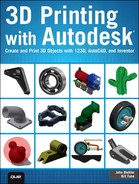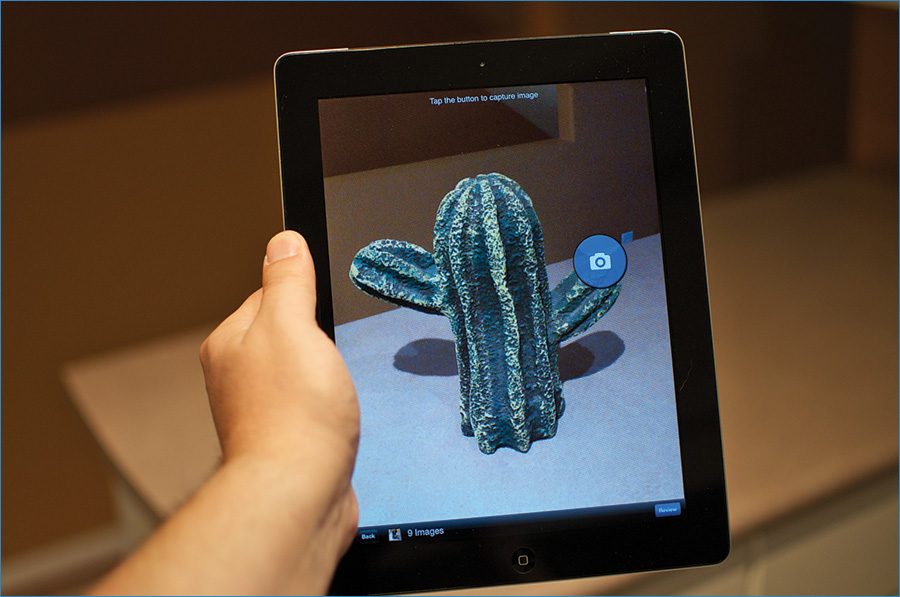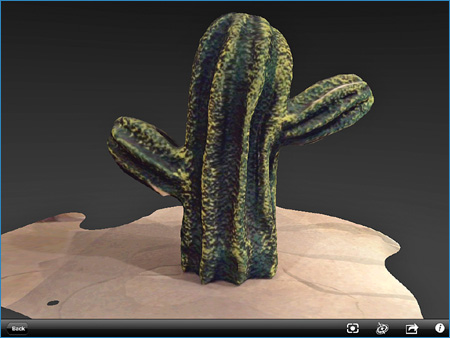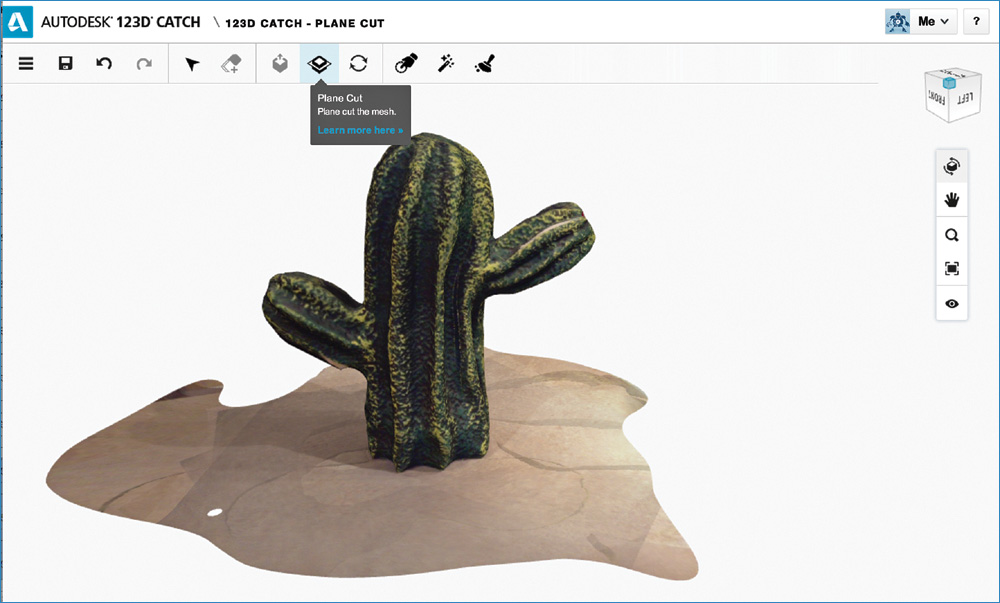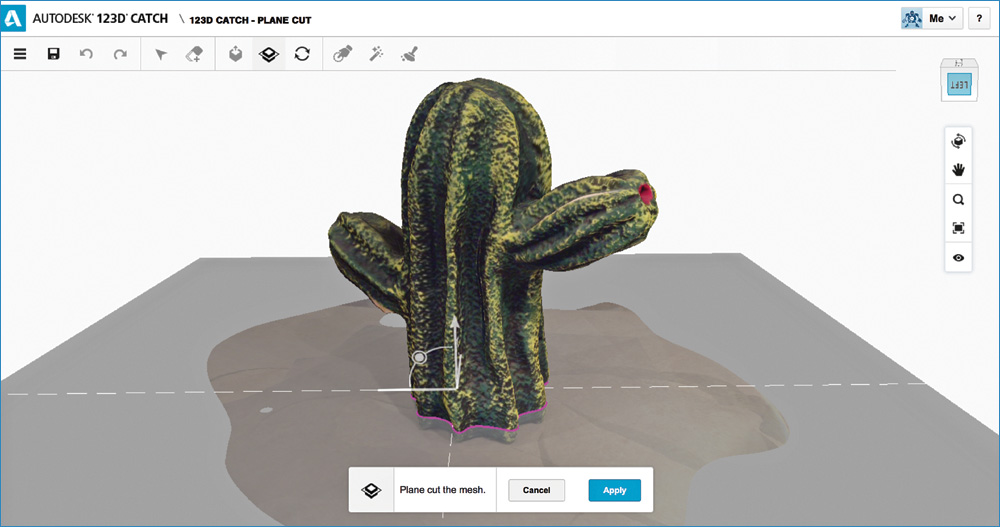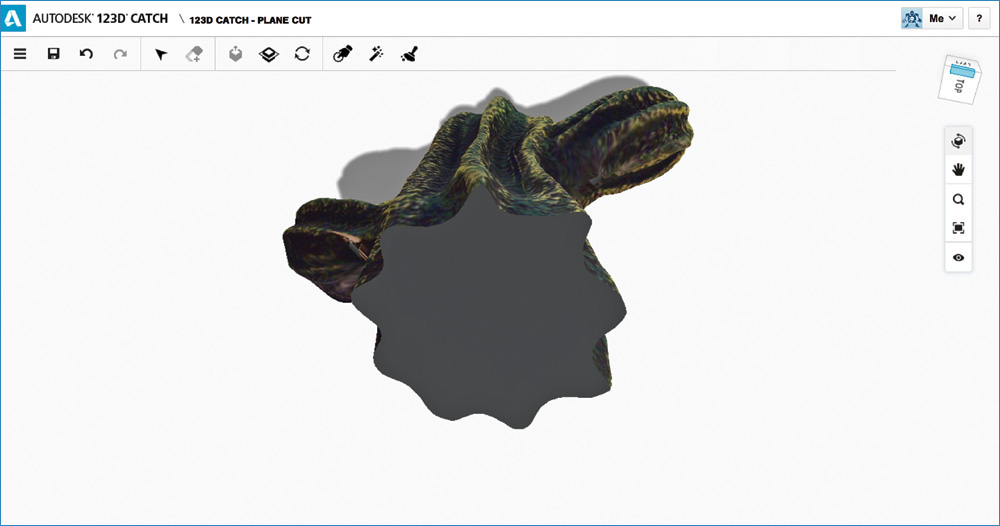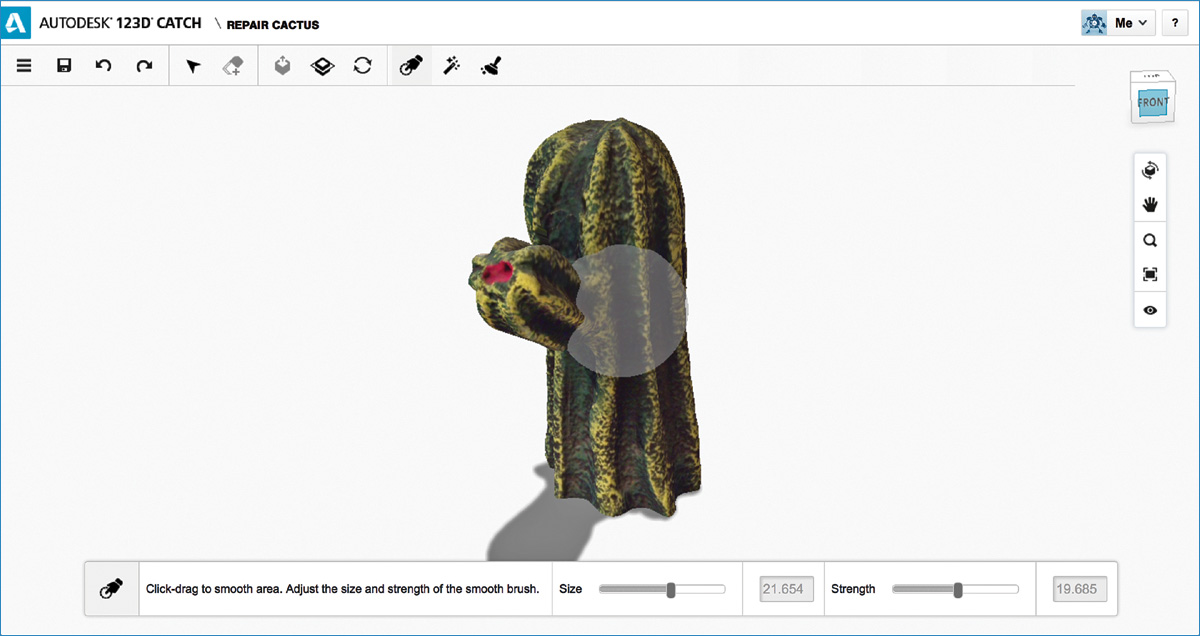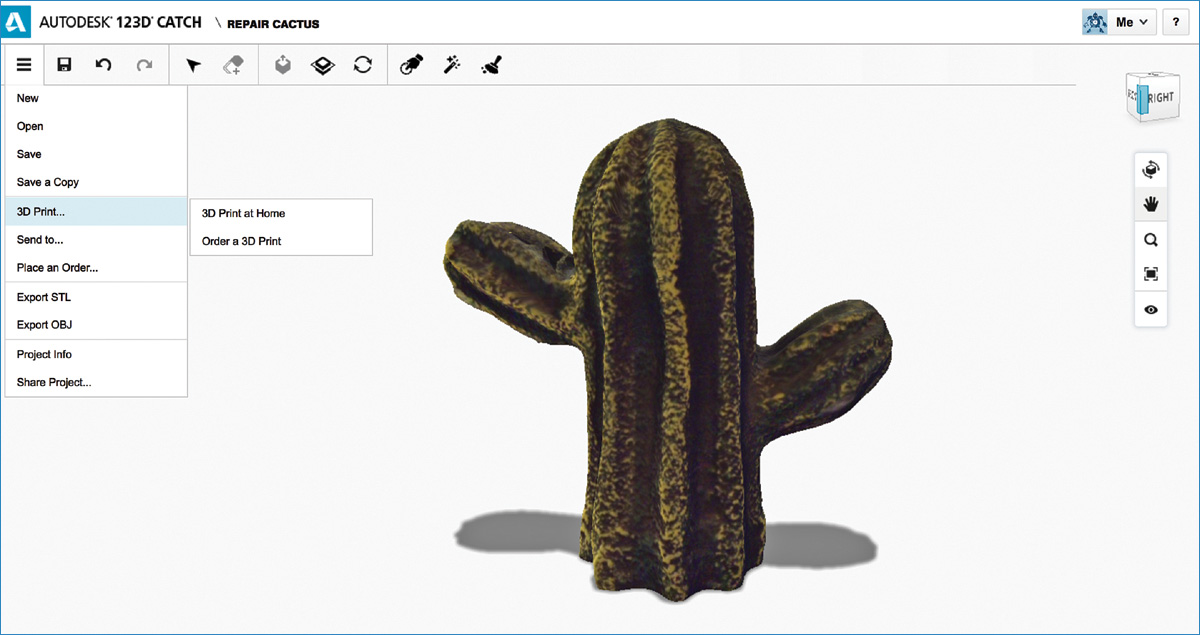4. Creating 3D Objects with Cameras and 123D Catch
Autodesk has a free service called 123D Catch that allows you to scan objects in 3D of just about anything, including people or buildings, using a regular digital camera—even with the one in your smartphone or tablet.
Note
You will need to set up an Autodesk account (it’s free) before you can start. The process is quick and only requires a valid email address. It can be done via the application directly or via the website at http://123dapp.com.
There are a couple of ways to use 123D Catch. In this chapter, we cover the use of the iOS and web versions of the software. Both require that you take multiple photos of your object, from every angle possible. Then you submit those photos to the 123D servers either from within the Apple iOS app or via your browser.
Note
123D Catch is not currently available for Android devices but works with any mobile iOS device from Apple that has a camera such as an iPhone, iPad (see Figure 4.1), or iPod Touch.
The 123D website then processes those images and presents you a 3D model of the object. We go over some tips to ensure the best possible success in capturing your model.
Note
123D Catch doesn’t require the use of an Apple device. You can use any camera and upload the photos using the website version of the application. The same tips apply when using your own camera. The iOS app just saves you the step of having to manually upload the photos.
Photographing Objects
Let’s start with a handmade ceramic cactus that was purchased at a street market in Mexico about 20 years ago. The scanning process works best with objects that aren’t shiny because reflections can cause problems while processing the model.
Tip
If you have an object with a shiny or reflective surface, you can apply something such as cornstarch, flour, or a similar powder to make that surface less reflective. The same applies if you are scanning people. Dark hair doesn’t register as well as lighter hair. Applying a white powder (such as cornstarch) to dark hair will assist in bringing out the details in the model when scanning.
Using an iPad and the 123D Catch app, approximately 30 photos of the cactus were taken from every angle of it (see Figure 4.2).
Note
The 123D Catch app is free from the Apple App Store. Visit http://123Dapp.com/ for more information.
Start at one side of the object, and work your way around it, keeping the object fully in the frame, approximately the same distance for each photo. Alternatively, you can set up your camera in a fixed position and rotate the object you’re photographing. It’s better to have some overlap of the object in each photo than not because the software will figure out where to stitch the images together better.
Tip
Ideally, the background in the photos should be high contrast or complex compared to your object. Scanning a solid red object on a red table for example will lead to a poor scan. Simply using a sheet of (black-and-white) newspaper underneath your object can greatly improve your scanning results. This contrast helps the software separate your object from the background in the photos.
You can review what you’ve captured by pressing the Review button, as shown in Figure 4.3. You can delete images or retake specific angles if they didn’t turn out simply by tapping on the photo.
If you touch the screen on the iPad with one finger, you can rotate the model. Using two fingers at the same time, you can pinch and zoom to adjust your view of the model. The model also can appear upside-down depending on the orientation of the camera used to capture it.
When you’re happy with the results, press the Finish Capture button, which takes you back to the Captures tab. Press the Tap to Process button to begin the process of uploading the photos to the Autodesk servers and begin converting the images into your 3D model.
Note
This process can vary in length depending on how busy the servers are and how complex your model is, but it usually takes only a few minutes.
When the software finished processing the model, it gave me the 3D model of the cactus (see Figure 4.4).
Correcting the Model
There are a few issues with the model that need to be corrected; we walk through them here.
You’ll notice that the top of the surface on which your object was sitting may also be included in the model. Shortly, we’ll go through the steps to trim that off, leaving only the desired object behind as your 3D model.
After saving the model to your Autodesk account, you then can manipulate it further using the other Autodesk applications. We cover these in later chapters. Your model should appear in the Captures tab of 123D Catch on the iPad and in the My Projects section online after you log in to 123D Catch (see Figure 4.6).
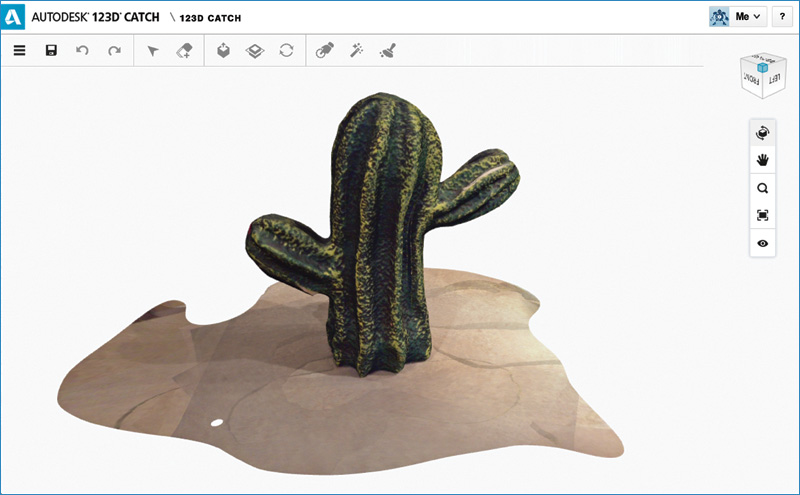
FIGURE 4.6 Reviewing the finished output 3D model of the cactus in the online version of 123D Catch.
As mentioned, the bottom of the model contains the surface on which the object was sitting when you captured the images. We’re going to use the Plane Cut tool to trim off the bottom of the model, leaving behind only the cactus object, as shown in Figure 4.7.
Select the Plane Cut tool from the toolbar. A set of controls should appear on your model with an arrow pointing along the Z axis. The bottom of this arrow represents the bottom of the model and direction the cut will occur. A circular control on both the X and Y axis lets you rotate the cutting surface and align it with the bottom of your model.
In Figure 4.8, the arrow is pointing down. It should be pointing up; otherwise the top of the cactus would get cut off. Click and drag your mouse on either the X or Y circle (below the purple line in Figure 4.8) to rotate the cut line. It should snap at the 45° and 90° positions to help with alignment.
When the arrow is orientated correctly, you can then click and drag it to move the cutting plane up and down your model (see Figure 4.9). In this example, you want to see only the purple line along the bottom of the cactus which means that the cut will discard the countertop surface.
Use the X- and Y-axis circles again to pivot the model along the plane until it’s level. The purple line represents the new bottom of the model. Press the Apply button when you’re happy with the position of the purple cutting line.
In Figure 4.10, you can see that the bottom of the model has been cut and the countertop surface has been removed from the model.
Orienting the Model
One last thing that you might need to do is orient the model so that it is upright for printing. You’ll notice in Figure 4.11 that in the upper-right corner of the screen the orientation box is upside-down.
To correct this, press the Orientate button from the menu; a blue plane appears on the model. Clicking the arrow enables you to rotate the model and correct the orientation (see Figure 4.12). In this example you need to rotate the model 180°.
Note that the upper-right box is now upright. You’ll need to save the model before you proceed to the next and final steps of repairing the model.
Repairing the Model
It’s not uncommon for scans to result in some holes or rough spots due to the software misinterpreting your source photos. This can be caused by a number of reasons, but usually it’s due to areas of the source object being in shadow or too similar to surrounding areas.
Fortunately, 123D Catch has some repair options included that will analyze the finished model. You can manually do some spot repairs to the model using the Smooth tool for rough areas and holes. Automatic repairs can be done using the Heal Mesh and Auto-Cleanup tools from the menu.
The Smooth tool is used to smooth out any rough points in the model that might not have been processed as accurately as desired. You can adjust the brush size using the slider on the bottom as well as the strength of the effect.
Start with small brush Size and low Strength; then work your way up (see Figure 4.13). You don’t want to apply too strong of an effect because it will look obvious on the model. Also, be sure you rotate around the model to smooth all sides of the model.
The Heal Mesh tool detects any holes in the model and repairs them. Inspect the model after applying this to ensure it doesn’t close openings that you intended to be open (see Figure 4.14).
The Auto-Cleanup option magically fixes the model and removes any of the detached parts of the object. This is the last step you should apply. Again, inspect the model from all sides to ensure it didn’t over-repair any parts of the model unnecessarily. Use the Undo option if you aren’t happy with the results.
Finally, you can choose to preview the model for your 3D printer software or send it to a printing service (see Figure 4.15).
![]() For more information on how to send your model to a 3D printing service, go to Chapter 16, “Using a Third-Party 3D Printing Service Bureau.”
For more information on how to send your model to a 3D printing service, go to Chapter 16, “Using a Third-Party 3D Printing Service Bureau.”
Summary
In this chapter, we used an iPad to photograph a physical object and create a 3D model from those photographs. Then, using a number of built-in tools, we cleaned up and repaired the model, getting it ready to send to a 3D printer.
In the next chapter, we dive into creating models from scratch using your iPad and 123D Design.
